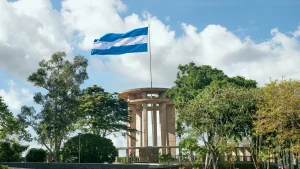The ethnic group of Los Miskitos in Honduras
The Miskito population is descended from the Chibcha tribes, who lived in the low forests of northern South America before the arrival of the Europeans.
The name Misquito, possibly comes from or is related to the «musket» that was the rifle introduced by the English and that was traded on that coast.
The origin of the Misquitos as an ethnic group is unclear. The Miskito themselves and many scholars consider that they have always been Miskito. Some authors agree that the Miskito people arose in the 17th century, from a social and biological mixture of Bawinkas, Tawahkas (Sumos), Africans and Europeans.
According to anthropological studies, biologically the Misquitus appear to be a mestizo group that develops after contact as a product of the mixture of the indigenous population with black and pirate and from the cultural point of view it seems that the Misquitus were originally a small group that lived nearby from Cabo de Gracias, the Bawinka linguistic group were members.
See Ethnicities of Honduras
It is believed that the name misquitu is derived from the word miskut-upla (chief court of the Tawiras population) and that in a synthesized form it is read miskitu which means the people of miskut.
During the 17th and 18th centuries and the mid-19th century, the English exploited the Mosquitia region, exercising their authority through the Moscos kings in the territory between the Río Tinto or Negro and the Río San Juan (Nicaragua). The dominance interest was not only economic, but also geostrategic against the United States.
In colonial times, the English offered them political-military support and in certain manufactures in exchange for the enslavement of other indigenous groups and products such as skins, tortoiseshell, food, etc.
This collaboration between Misquitus and the English made possible the expansion of this ethnic group, which extended from the Chiriquí lagoon in Panama to the Honduran-Guatemalan border, the historical process of formation of this town was completed in the second half of the XIX century. with the contact of the Misquitus with the Moravian and Catholic churches, which intervened directly in the constitution of the ideology and religiosity of the Misquitus to this day.
In 1711, the Bishop of Nicaragua described the origin of the «Zambos or Misquitos» as follows:
“In the year 1641, a ship loaded with blacks was lost on the coast of the North Sea and in the part between the mouth of the San Juan River, in the province of Nicaragua and the city of Trujillo, in the province of Honduras … a third of the The blacks and the others withdrew and took refuge among the undergrowth of those mountains occupied by the Carib Indians who, jealous and suspicious of those new guests, waged a very crude war with each other, over time the blacks overcame the Caribs, these retreating inland towards the mountains. lands of Segovia and Chontales … who today have fierce enmity with them … The victors multiplied with the women of the vanquished, and because those first guests have already died, today their descendants are called Zambos because they are children of blacks and Indians. «
History
Apparently, the Misquitos arose out of close contact with English pirates and Caribbean merchants in the course of the 17th century, as a result of the union of indigenous people with blacks and some whites.
The Miskito are until the present example of an ethnic group in which despite racial mixtures, the indigenous cultural heritage has been maintained. Among their means of subsistence was the smuggling and trade of English merchandise as well as the sale of slaves taken prisoner (pech and tawahkas) in their raids through neighboring territories.
The institution of a reign with a hereditary character was also part of the Miskito tradition. The king symbolized for the Miskitos, the top of the political order, he represented the interests of his people against foreigners, he was the judge and the highest military authority.
Upon the arrival of the English, the position of this king was legitimized by them and the «coronation» of the same took place by mandate of the English themselves in Jamaica or Belize (both places were capitals of English rule in the Caribbean).
In practice, the king never had any authority or supremacy in the control of internal and external politics, he was a puppet of the English positioned only as a central figure of local power.
Due to this, the community and the family exercised the foundations of the political life of the Miskito, whose autonomy was barely touched by the state power.
In the mid-nineteenth century, definitive changes took place, the English moved the residence of the Miskito king from Sandy Bay (near Cape Gracias a Dios) to Bluefields, the capital of the Miskito-Territory protectorate, whose political organization was increasingly acquiring the features of A state.
With this, the Miskito king fell under the direct influence of the English consul and then of the population of the capital, that is, the Creoles (Afro-Americans of Antillean origin) and foreign immigrants. At this time the warlike expansion of the Misquitos ended and their growing link to an export economy as rubber gatherers and fishermen began.
At present, the Misquitos form the largest population group in the Mosquitia, with an estimated 30,000 members of this ethnic group.
What’s more
- Get to know the Ethnicities and Indigenous Groups of Honduras
- Map of Ethnicities and Indigenous Groups in Honduras
- Río Plátano Biosphere Reserve



